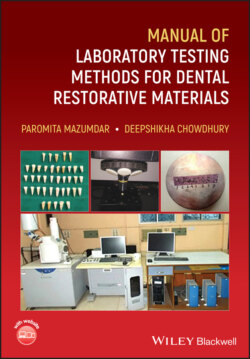Читать книгу Manual of Laboratory Testing Methods for Dental Restorative Materials - Paromita Mazumdar - Страница 10
1 Assessment of Mechanical Properties of Dental Restorative Materials KEY CONCEPTS
ОглавлениеKnowledge of properties of dental restorative materials.
Ability to differentiate between each type of mechanical properties.
Understanding of the type of sample preparation required for the different testing modalities.
Working principle of the equipment used.
Different applications of the universal testing machine.
In the oral environment, restorations are subjected to stresses from mastication. These forces act on teeth and/ or material producing different reactions that lead to deformation, which can ultimately compromise their durability over time [1–5].When a specific force or load is applied to a body, a reaction of the same intensity and with opposite direction is produced which causes an internal tension. Hence, it is possible to quantify the reaction that resulted by the applied external load. Since shape and dimensions of specimens under test can be measured, one can calculate stress by the reason between force and unit area.
Depending on the applied load characteristics and consequent stress, different reactions from the tested material may occur. The stress can result in structural alteration of original dimensions. The rate between this alteration by the original dimension results in deformation, that is defined as strain. The stress–strain ratio of a material is relevant to determine its mechanical behavior. For each material, there is a stress–strain proportional relationship, establishing a stress–strain curve. If there is a stress relief during loading and no permanent deformation occurs, it demonstrated its elasticity. This proportion occurs until a limit point that is defined as proportional limit and deformation as elastic deformation. In this point, the maximum stress of a material will withstand without permanent deformation. As stress–strain is proportional until this point, there is a constant proportionality. It determines the elasticity of a material and is calculated by the ratio of stress–strain curve within the elastic limit. This proportionality is defined as modulus of elasticity or Young's modulus. This value will measure the stiffness of such material. However, when the applied load exceeds this point, irreversible deformation occurs, resulting in permanent or plastic deformation. Each material presents a resistance to deformation, and after this point, it will result in its rupture. In this point ultimate strength value is obtained. Toughness is the resistance of a material to fracture and corresponds to the amount of energy required to cause it [6]. All these concepts can be applied in clinical situations as many complex forces occur in the oral cavity and tend to deform the material (tensile, compressive, shear, bending forces), the knowledge and interpretation of how these materials behave under such forces are important to understand the performance of the material. Thus the various mechanical parameters that are evaluated for the suitability of a product for any application in the field of conservative dentistry are as follows:
